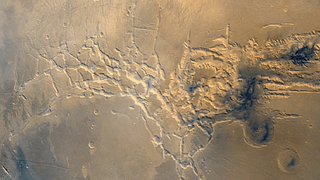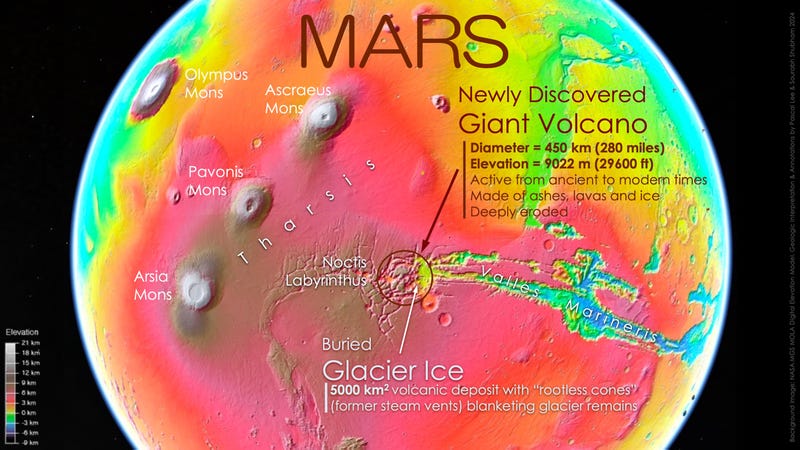A giant volcano has been found in Mars’ Tharsis plateau, making it the fourth known volcano in the region. Heavily eroded, the 29,600-foot (9,022-meter) volcano has been hiding in plain sight, sneaking its mug into images of the Tharsis region but never actually being seen. Until now.
The volcano’s discovery was announced this week at the 55th Lunar and Planetary Science Conference in Texas. Abutting the maze-like geology of Noctis Labyrinthus, the giant volcano has been provisionally named Noctis Mons. You can read the paper initially describing the discovery here. The volcano was found with data from multiple Mars orbiters, including NASA’s Viking orbiters and the Mars Reconnaissance Orbiter, and ESA’s Mars Express orbiter.

“It’s an ancient and long-lived volcano so deeply eroded that you could hike, drive, or fly through it to examine, sample, and date different parts of its interior to study Mars’ evolution through time,” Pascal Lee, a planetary scientist at the SETI Institute and the lead author of the new study, said in an institute release. “It has also had a long history of heat interacting with water and ice, which makes it a prime location for astrobiology and our search for signs of life.
The volcano is on the western edge of Valles Marineris, a vast canyon system on Mars that is 10 times longer, 20 times wider, and five times deeper than the Grand Canyon. It was spotted “hiding near Mars’ equator in plain sight,” according to the press release. The team believes the volcano is a shield composed of layered lava, ice, and pyroclastic material. As faults and fractures formed in the volcano, lava rose, causing thermal erosion and, ultimately, the collapse of swaths of the volcano.

While the newly discovered volcano just edges out Mount Everest (29,000 feet, or 8,839 meters) in the height department, it’s comfortably dwarfed by Mars’ largest volcano, Olympus Mons, which is the size of Arizona and an imposing 16 miles (25.75 kilometers) high.
Last year, the team found a relict glacier in the geologically young region, a hopeful sign for future human habitation on a cold, arid, generally inhospitable world. That finding was announced at last year’s Lunar and Planetary Science conference. Upon further investigation, “we realized we were inside a huge and deeply eroded volcano,” Lee said.
“Finally, with glacier ice likely still preserved near the surface in a relatively warm equatorial region on Mars, the place is looking very attractive for robotic and human exploration,” he added.
If ice were preserved near the Martian surface, it would be a compelling venue for human habitation. How to produce food, water, and even air on Mars will be critical problems to solve if aspirations of human exploration of other planets (and beyond!) is to occur.
Mars’ volcanoes don’t have Vesuvian outbursts—at least none that scientists have observed. But the planet is seismically active: in 2022, the since-decommissioned InSight lander spotted potential signs of magma in seismic data.
